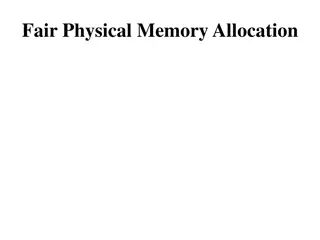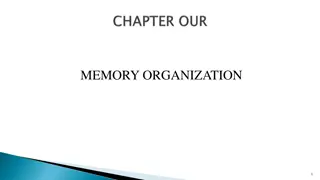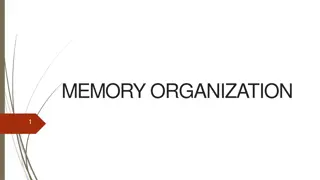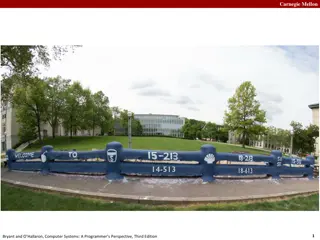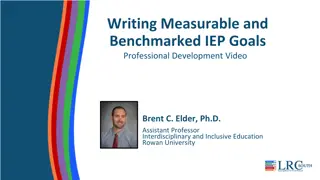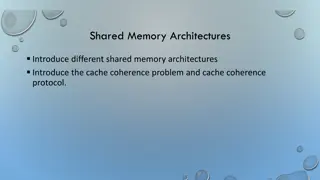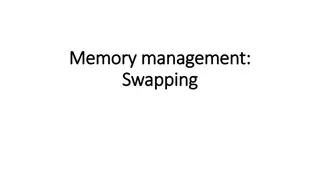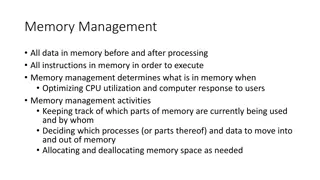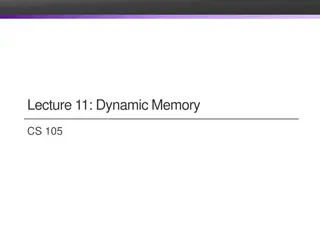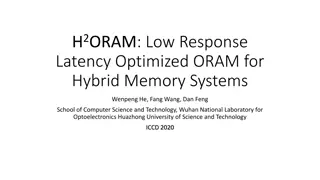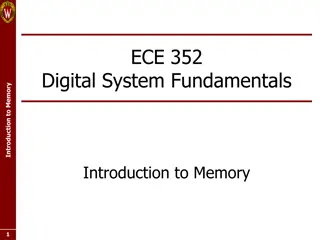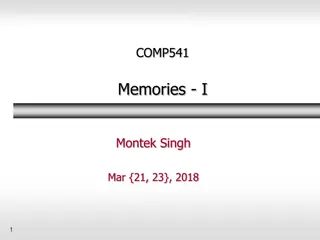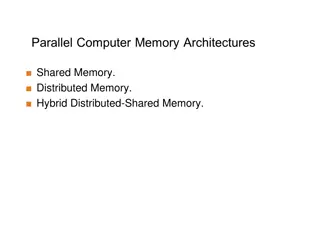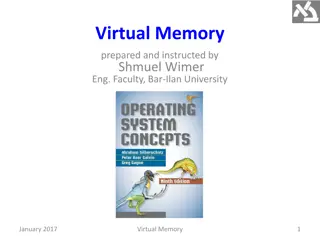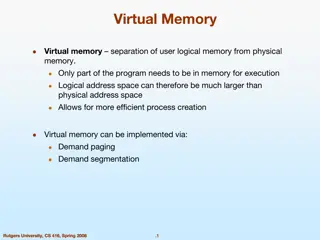CXL Benchmarking Framework for Memory Optimization
This content delves into a CXL benchmarking framework focused on optimizing memory access patterns, allocation policies, and infrastructure configurations. It explores potential use cases, emulation techniques, and the detection of bottlenecks in CXL infrastructure for improved performance and cost efficiency.
Download Presentation

Please find below an Image/Link to download the presentation.
The content on the website is provided AS IS for your information and personal use only. It may not be sold, licensed, or shared on other websites without obtaining consent from the author.If you encounter any issues during the download, it is possible that the publisher has removed the file from their server.
You are allowed to download the files provided on this website for personal or commercial use, subject to the condition that they are used lawfully. All files are the property of their respective owners.
The content on the website is provided AS IS for your information and personal use only. It may not be sold, licensed, or shared on other websites without obtaining consent from the author.
E N D
Presentation Transcript
CXL benchmarking Viacheslav Dubeyko Adam Manzanares 1
Content 1. 2. 3. 4. 5. 6. 7. Problem declaration Potential target use-cases Emulation of target use-cases Emulation of different types of CXL memory and CXL device types Benchmarking framework Benchmarking results interpretation Open questions 2
CXL benchmarking problem Determination allocation policy and memory access pattern(s) capable of improving an application performance Determination memory (CXL) configuration and migration policy capable of decreasing a total latency of particular memory access pattern Emulation of CXL infrastructure with the goal of determination an efficient configuration Detection of CXL infrastructure bottlenecks Continuous detection/management of CXL infrastructure latency/performance degradation Elaboration of CXL infrastructure architecture capable of decreasing TCO cost 3
Potential target use-cases Huge relational and NoSQL databases In-memory database Social networks AI/ML workloads 4
Target use-cases emulation problem Thread 1 Thread n Thread 2 Memory Time Read/ write Read/ write Allocate Allocate Free Free Memory access pattern 5
Memory access patterns emulation Time gap between operations Allocated memory migration Threads number Allocation/Free size Memory access pattern Read size Access size Write size Memory type selection 6
Optimization problem Application memory access pattern (not optimized) Pattern 1 Pattern 2 Pattern 1 Pattern 2 Pattern n Time Pattern 1 Pattern 2 Pattern 1 Pattern 2 Pattern n Optimization Application memory access pattern (optimized) 7
Optimization problem Y = f(X) {Capacity 1, , Capacity n, Allocation policy} = f{Access pattern, Latency 1, , Latency n} Memory 1 Memory 2 Memory 3 Memory n Capacity 1 Latency 1 Capacity 2 Latency 2 Capacity 3 Latency 3 Capacity n Latency n Switch 1 Switch n Local DRAM Local CXL Persistent memory Remote CXL 1 Remote CXL n 8
Optimization workflow Monitoring memory access parameters Repeatable memory access patterns detection Memory access patterns classification (frequency + duration) Select (prioritize) memory access patterns for optimization Pattern analysis and detection of area(s) for optimization Simulation of memory accesses distribution on various memory types Best outcome searching Interpretation and feasibility analysis of the found best outcome Elaboration allocation and memory migration policy among memory tiers Testing optimization policy 9
CXL memory types emulation 1. 2. 3. 4. 5. NUMA nodes [1, 6] Hardware prototype [2, 3, 4] RAMdisk on remote nodes [5] QEMU-based emulation [7] Mathematical model + empirical estimation??? a. HDD, SSD -> swap b. List data structure as latency management List data structure as latency management Swap (persistent memory) RAMdisk (remote node) NUMA nodes Hardware prototype QEMU-based emulation Mathematical model??? 1 2 3 4 5 1. Li, Huaicheng, et al. Pond: CXL-based memory pooling systems for cloud platforms. Proceedings of the 28th ACM International Conference on Architectural Support for Programming Languages and Operating Systems, Volume 2. 2023. Gouk, D., Lee, S., Kwon, M. & Jung, M. Direct Access, High-Performance Memory Disaggregation with DirectCXL. 2022 USENIX Annual Technical Conference (USENIX ATC 22). pp. 287- 294 (2022,7) M. Jung, Hello bytes, bye blocks: PCIe storage meets compute express link for memory expansion (CXL-SSD) . In Proceedings of the 14th ACM Workshop on Hot Topics in Storage and File Systems (HotStorage 22). Association for Computing Machinery, New York, NY, USA, 45 51. M. Ahn et al., Enabling CXL memory expansion for in-memory database management systems, Data Management on New Hardware, 2022. M. D. Flouris, E. P. Markatos. The Network RamDisk: Using remote memory on heterogeneous NOWs . Cluster Computing 2, 4 (1999), 281 293. Wahlgren, J., Gokhale, M. & Peng, I. Evaluating Emerging CXL-enabled Memory Pooling for HPC Systems. ArXiv Preprint ArXiv:2211.02682. (2022) Raja Gond and Purushottam Kulkarni, emucxl: an emulation framework for CXL-based disaggregated memory applications. ArXiv Preprint arXiv:2404.08311 (2024) 2. 3. 4. 5. 6. 7. 10
Potential memory type selection policies Priority-based allocation policy higher priority in local DRAM, lower priority in CXL memory Size-based allocation policy smaller sizes in local DRAM, bigger sizes in CXL memory Pre-fetch based allocation policy pre-fetching from persistent memory into CXL memory Pre-allocation based policy pre-allocation big chunks of memory (memory pool) in CXL memory Pre-mapping based policy page faults elimination by pre-mapping physical memory pages for virtual address space Lifetime based allocation policy short-lived memory chunks in local DRAM, long-lived memory chunks in CXL memory application-based hints on memory chunks lifetime lifetime-based memory heaps (short-lived, long-lived memory pools) 11
Potential allocated data migration policies Dynamic lifetime-based policy initial allocation from short-lived memory pool (local DRAM) growing lifetime initiates migration in longer-lived memory pools (CXL memory) Swap-based migration policy swapping from local DRAM into CXL memory File system like interaction between local DRAM and CXL memory pre-fetching portion of CXL memory content into local DRAM hardware-based management??? 12
CXL benchmarking framework Memory access pattern detection tool Memory access pattern emulation tool APP CXL memory emulator Optimization tool (ML based) CXL infrastructure Benchmarking tracing tool 13
CXL Fabric Manager (FM) as benchmarking subsystem Host #1 App #1 CXL switch #1 App #n CXL FM Disaggregated CXL memory pool ML subsystem continuous benchmarking + policy elaboration Host #n App #1 CXL switch #n App #n 14
Open questions How to emulate memory latency? How to emulate application behavior? How to estimate application performance? How to treat benchmarking results? How good is good numbers? How bad is bad numbers? Isolated workload vs. real-life environment? How to identify and isolate code patterns determining application behavior sensitive to memory allocation types? How feasible is implementation of found best optimization outcomes? How useful can be an abstractness of mathematical model? 15
THANK YOU QUESTIONS??? 16
Allocate/free memory patterns Set of typical allocation sizes Set of typical lifetimes of allocated memory Application Distribution of allocation with time Distribution of deallocation with time Variation of distribution with time 17
Read/write memory patterns Set of typical access sizes Types of accessed memory (volatile, persistent) Application Set of typical latencies Distribution of accesses with time Total/average time gap between memory accesses Distribution of time gaps with time 18
CXL benchmarking framework (1) Record application s memory access pattern (2) Reproduce (emulate) + benchmark an application s memory access pattern (3) Analyze and recognize memory access sub-patterns (4) Classify sub-patterns on the basis of frequency, latency, and priority (5) Select sub-patterns for optimization (6) Analyze sub-patterns peculiarities + select optimization techniques (7) Emulate application s memory access patterns with optimized sub-patterns (8) Benchmark application s memory access patterns on emulated CXL memory (9) Normalize benchmarking results (10) Detection of responsible programming patterns and feasibility of optimization 19
Correct latency and performance estimation problem Record memory access pattern Distinguish memory allocation and memory access subpatterns How to emulate memory latency? Redistribution memory allocation among memory tiers How to emulate application behavior? How to estimate application performance? Memory type latency emulation How to treat benchmarking results? Memory access reproduction Benchmarking memory access pattern 20
Benchmarking result interpretation problem How good is good numbers? How bad is bad numbers? Measured numbers variation Latency emulation approach Measurement approach Approach of redistribution memory allocation among tiers Abstractness of mathematical model Isolated workload vs. real-life environment? How to identify and isolate code patterns determining application behavior sensitive to memory allocation types? How feasible is implementation of found best optimization outcomes? 21


